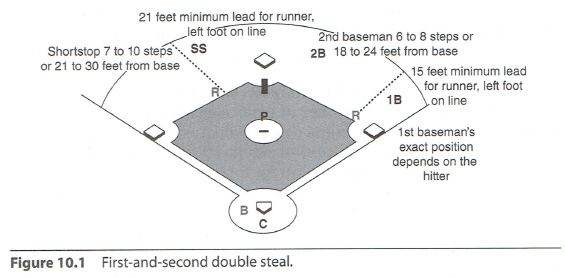|
Best Pitch for the Double Steal By: Mike Roberts Provided by: Human Kinetics
The runners on first and second base have equal importance in executing the double steal (see figure 10.1). Some coaches seem to think that the runner on first base is not as important since this runner does not have to run just because the runner on second takes off. However, the runner on first base needs to execute as well as the runner on second. If he practices often, the runner on first will be able to read the runner on second and simultaneously jump to steal. Best Pitch for the Double Steal The best pitch for stealing a base is the first pitch after a runner arrives on base. This is especially true in a first-and-second double-steal situation. Why the first pitch? In my early years as a head coach, my father would ask me why I liked to run on the first pitch. He'd ask what the difference was between the first pitch and, say, the fourth pitch. This is a legitimate question and one I enjoy answering. Running on the first pitch has several advantages. First, the pitcher, unless he has an incredibly professional approach, is usu-ally upset or at least bothered by the fact there are runners on first and second base. Maybe the runner at second hit a double and the pitcher walked the next hitter to place runners on first and second. Possibly the pitcher walked both hitters, or there was a runner on first, a ground ball to an infielder was booted, and now instead of a double play and no one on, there are runners at first and second base. It's understandable that the pitcher is at least flustered by the run¬ners on first and second and is not paying much attention to the base runners. Remember, it is the primary responsibility of the pitcher to get the next hitter out. Pitchers are taught to regard the hitter as their primary focus. The infielders' role is to hold the runners close to keep them from stealing the next base. However, few infielders seem to know how to force a runner back if he does have a good lead or at least keep him flat-footed so it is more difficult to steal. The defense wants to hold the runners close, but there is usually little effort to do so early in the count. The effort to hold runners on usually comes after the defense sees a threat to steal. By this time, if the runners are serious about pulling off a double steal, they should already be in motion early in the count. Base runners in a first-and-second double-steal situation can't know how many pitches will be made to the next hitter. Each pitch could mean the runners are moving on contact, a play that eliminates the double steal. If there are no outs, a coach may decide to bunt on the first or second pitch to move the runners up. My preference is to steal the bases and save the out. The earlier in the count, the better the opportunity to make it happen successfully. Pitchers have become rote through the years, sadly leaving ath-leticism behind to a large degree. As a group, they have lost their ability to move around the mound with rhythm and ease. Because pitchers don't vary their looks much today, it's that much easier for base runners to steal. Add to this the fact that a majority of pickoff signals, even in the major leagues, come from the bench. Coaches are rarely prepared to call those pickoffs on the first pitch because their focus also is on the hitter. Just like the pitcher, coaches often don't focus on the base runners. This too adds to the base runner's advantage. In almost all amateur leagues, even down to those with kids 8 to 10 years of age, pitches are called from the bench. Usually the same coach calls the pitches and pickoffs. This saves the catcher from having to look into the dugout for multiple coaches. The problem is that the coach has to switch back and forth from a pitch-calling to a defensive mode. This is difficult to do well and still keep the pitcher in some kind of rhythm. Once again, the hitter receives most of the attention. If a catcher is a true gamer and understands the instinctive details of the game well, a coach should not have to call any signals during a game. A coach and catcher should discuss strategy and signals in the dugout between innings. The coach can continue to teach but not while a hitter is at the plate. A catcher matures quickly when assuming pitch-calling responsibilities. Some pitchers, with or without a signal from the bench, use an inside move to force the base runner to hesitate. For an inside move, from the stretch position the pitcher lifts his front leg and spins the leg back toward second base. This move is not very productive for the pitcher but is used to try to deceive the runner. The key is for runners to realize that rarely is a middle infielder at the base to catch the throw when the pitcher makes his turn. It seems almost all of the inside moves today are for show only and not actual pick-off attempts. This makes it simple for the base runner to honor the move. However, it does not deter the base runner from stealing if he has the rhythm of base stealing down. A base runner is at his most confident and aggressive after he first reaches base because no one has had the chance to make him hesi¬tate. This makes it ideal to attempt the double steal on the first pitch or at least very early in the count. Base runners know the infielders, pitcher, and coaches are rarely prepared to give them much attention prior to the first pitch to the next batter. So if the base runners are prepared to move on the first pitch, they are more relaxed than at any time during a count. If for any reason the lead runner does not get an excellent jump on the first pitch and shuts it down, the runners still have the opportunity to run early in the count. They have more than one pitch or chance to steal before much defensive pressure is applied.
|







